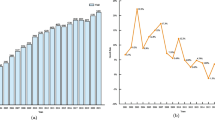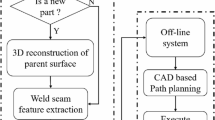Abstract
To tackle the issues of low efficiency and inaccurate results in the automated grinding of large castings, this paper presents a pioneering technique for generating grinding paths. The method combines the capabilities of the random sample consensus (RANSAC) and iterative closest point (ICP) algorithms. The RANSAC is used for discovering local feature point clouds, while the ICP estimates geometric deviations due to shrinkage and expansion. The expansion–contraction similarity (ECS) is pivotal to this approach, facilitating direct generation of global grinding path points from scant local ones. After comparing outcomes to two other methodologies and conducting a robot casting component experiment, the effectiveness and superiority of this technique were proved.










Similar content being viewed by others
References
Singh R, Madan J (2013) Systematic approach for automated determination of parting line for die-cast parts. Robot Cim-Int Manuf 29:346–366
Wang DN, Peters FE, Frank MC (2017) A semiautomatic, cleaning room grinding method for the metalcasting industry. J Manuf Sci E-T ASME 137:121017
Zhu DH, Feng XZ, Xu XH, Yang ZY (2020) Robotic grinding of complex components: a step towards efficient and intelligent grinding-challenges, solutions, and applications. Robot Cim-Int Manuf 65:101908
Wei YZ, Xu QS (2022) Design of a new passive end-effector based on constant-force mechanism for robotic polishing. Robot Cim-Int Manuf 74:102278
Li YF, Wang M, An ZY (2020) Spherical edge burr formation during servo valve spool shoulder grinding: identifying the formation mechanism and designing a deburring device. Int J Adv Manuf Tech 109:1929–1940
Kamath AK, Linke BS, Chu CH (2020) Enabling advanced process control for manual grinding operations. Smart Sustain Manuf 4:210–230
Jin SY, Pramanik A, Basak AK (2020) Burr formation and its treatments-a review. Int J Adv Manuf Tech 107:2189–2210
Kim CH, Chung JH, Hong DH (2008) Coordination control of an active pneumatic deburring tool. Robot Cim-Int Manuf 24:462–471
Maiolino P, Woolley R, Branson D (2017) Flexible robot sealant dispensing cell using RGB-d sensor and off-line programming. Robot Cim-Int Manuf 48:188–195
Liu Y, Tang Q, Tian X (2019) A discrete method of sphere-pipe intersecting curve for robot welding by offline programming. Robot Cim-Int Manuf 57:404–411
Mitsi S, Bouzakis KD, Mansour G (2005) Off-line programming of an industrial robot for manufacturing. Int J Adv Manuf Technol 26:262–267
Li WM, Song PF (2015) A modified ICP algorithm based on dynamic adjustment factor for registration of point cloud and CAD model. Pattern Recogn Lett 65:88–94
Fan JJ, Ma LQ, Zou Z (2020) A registration method of point cloud to CAD model based on edge matching. Optik 219:165223
Li XD, Li W, Jiang HZ (2013) Automatic evaluation of grinding allowance of precision castings based on plane features from 3D point cloud. Comput Ind 64:1129–1137
Huang WW, Mei XS, Jiang GD (2021) An on-machine tool path generation method based on hybrid and local point cloud registration for laser deburring of ceramic cores. J Intell Manuf. https://doi.org/10.1007/s10845-021-01779-y
Song HC, Song JB (2013) Precision robotic deburring based on force control for arbitrarily shaped workpiece using CAD model matching. Int J Precis Eng Man 14:85–91
Cuypers W, Gestel NV, Voet A (2009) Optical measurement techniques for mobile and large-scale dimensional metrology. Opt Laser Eng 47:292–300
Wang XF, Zhang XQ, Ren XK (2020) Point cloud 3D parent surface reconstruction and weld seam feature extraction for robotic grinding path planning. Int J Adv Manuf Tech 107:827–841
Feng HJ, Ren XK, Li LF (2021) A novel feature-guided trajectory generation method based on point cloud for robotic grinding of freeform welds. Int J Adv Manuf Tech 115:1763–1781
Yang L, Liu YH, Peng JZ (2020) A novel system for off-line 3D seam extraction and path planning based on point cloud segmentation for arc welding robot. Robot Cim-Int Manuf 64:10129
Dong Y, Guo X, Ye Q (2022) Shrinkage during solidification of complex structure castings based on convolutional neural network deformation prediction research. Int J Adv Manuf Tech 118:4073–4084
Xu XH, Zhu DH, Zhang HY (2019) Application of novel force control strategies to enhance robotic abrasive belt grinding quality of aero-engine blades. Chinese J Aeronaut 32:2368–2382
Funding
This research work was supported by the National Natural Science Foundation of China (Grant Nos. 62027812, 51875391 and 52275027).
Author information
Authors and Affiliations
Contributions
All authors contributed to the conception and design of the study. Experimental design, material preparation, data collection, and analysis were performed by Meng Wang and Yimin Song. The first draft of the manuscript was written by Meng Wang, and all authors commented on earlier versions of the manuscript. All authors read and approved the final version of the manuscript.
Corresponding author
Ethics declarations
Competing interests
The authors declare no competing interests.
Additional information
Publisher's Note
Springer Nature remains neutral with regard to jurisdictional claims in published maps and institutional affiliations.
Rights and permissions
Springer Nature or its licensor (e.g. a society or other partner) holds exclusive rights to this article under a publishing agreement with the author(s) or other rightsholder(s); author self-archiving of the accepted manuscript version of this article is solely governed by the terms of such publishing agreement and applicable law.
About this article
Cite this article
Wang, M., Song, Y. & Wang, P. A novel grinding path generation method for removing the parting line of large casting. Int J Adv Manuf Technol 131, 201–209 (2024). https://doi.org/10.1007/s00170-024-13121-w
Received:
Accepted:
Published:
Issue Date:
DOI: https://doi.org/10.1007/s00170-024-13121-w




